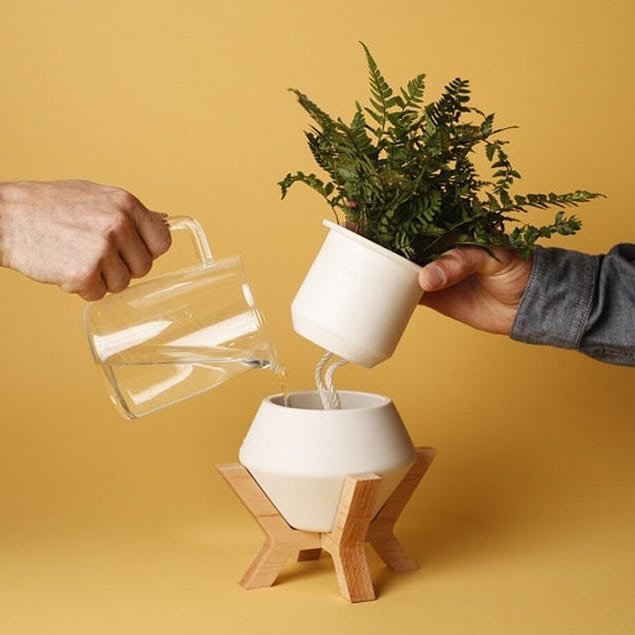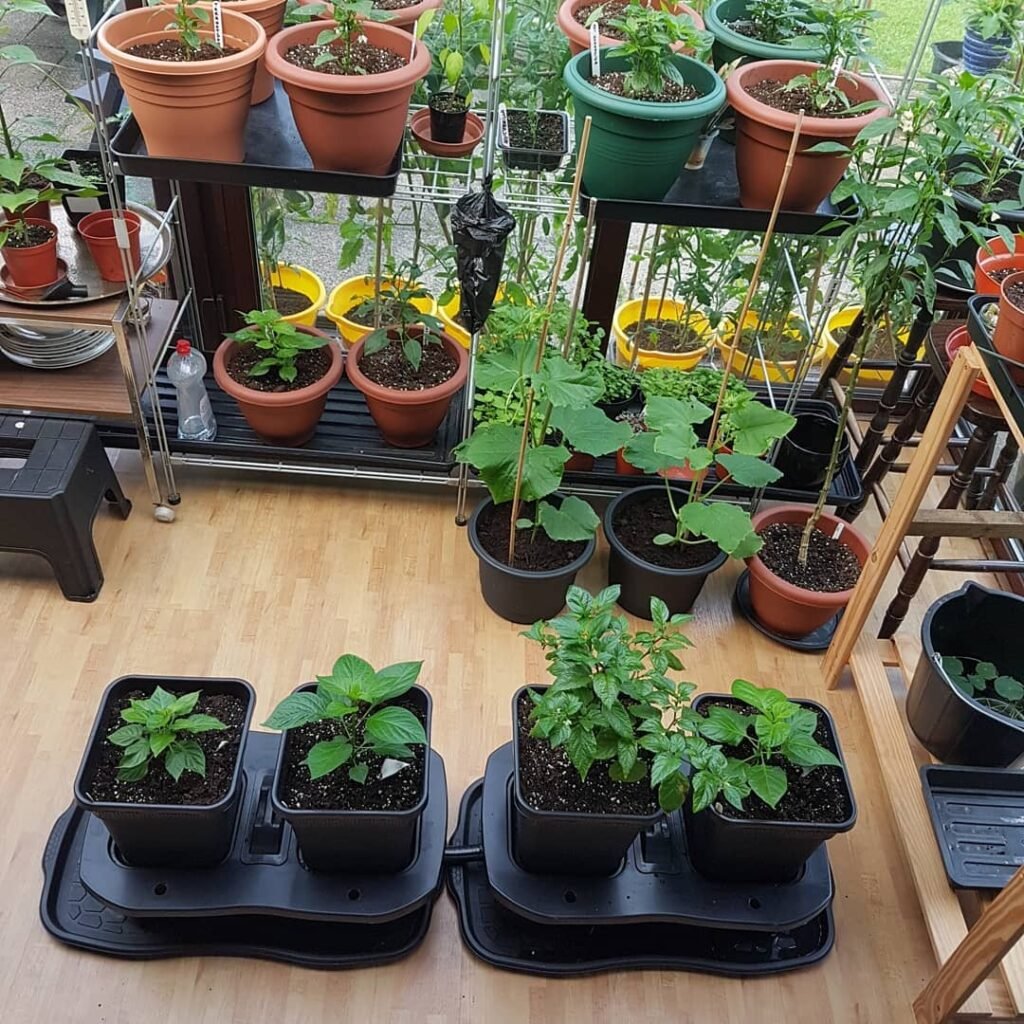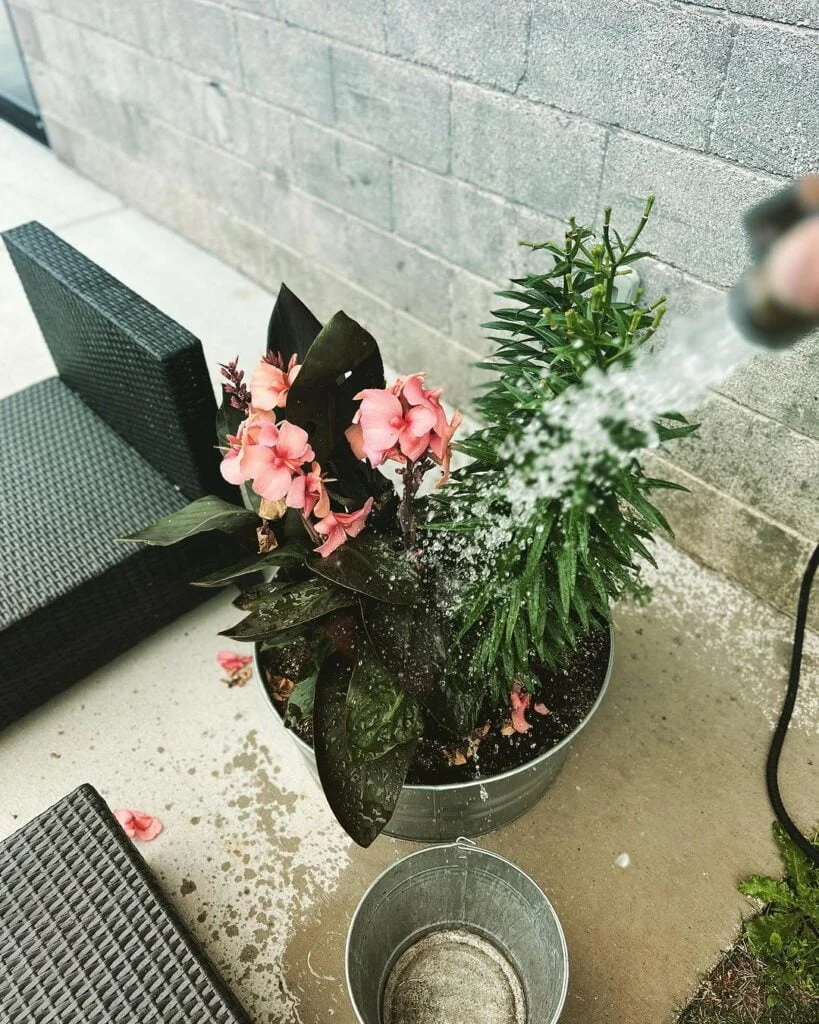Discover the convenience of self-watering indoor plant pots. Learn how these innovative pots help you maintain healthy plants with minimal effort and care.
In our busy lives, maintaining healthy indoor plants can be challenging. Enter self-watering pots – an innovative solution that helps keep your plants thriving with minimal effort. This guide will explore the benefits, types, and uses of self-watering indoor plant pots, helping you create a lush, low-maintenance indoor garden.
What Are Self-Watering Pots?

Self-watering pots are containers designed with a built-in reservoir that supplies water to the plant as needed. They typically consist of:
- An outer pot that holds the water reservoir
- An inner pot or growing container with drainage holes
- A wick system or perforated barrier that allows water to move from the reservoir to the soil
For a detailed explanation of how self-watering pots work, visit Gardening Know How’s guide on self-watering planters.
Benefits of Self-Watering Pots

Self-watering pots offer numerous advantages for indoor gardeners:
- Consistent moisture: Plants receive a steady supply of water, reducing stress from drought or overwatering.
- Water conservation: Less water is lost to evaporation or overwatering.
- Time-saving: Reduces the frequency of watering, ideal for busy individuals or frequent travelers.
- Improved plant health: Consistent moisture promotes healthier root systems and overall plant growth.
- Versatility: Suitable for a wide range of plants, from herbs to tropical species.
Learn more about the benefits of self-watering systems from the University of Illinois Extension.
Types of Self-Watering Pots

Several types of self-watering pots are available, each with unique features:
- Reservoir-based systems: The most common type, featuring a separate water reservoir at the bottom of the pot.
- Wicking systems: Use a wick to draw water from the reservoir to the soil.
- Sub-irrigation planters: Water is introduced from the bottom and absorbed upwards through capillary action.
- Smart self-watering pots: Incorporate technology to monitor soil moisture and automate watering.
Explore different self-watering pot designs at Apartment Therapy’s roundup of self-watering planters.
Choosing the Right Self-Watering Pot

Consider these factors when selecting a self-watering pot:
- Plant type: Choose a pot size and design suitable for your specific plants.
- Reservoir capacity: Larger reservoirs require less frequent refilling.
- Material: Options include plastic, ceramic, and metal, each with pros and cons.
- Aesthetics: Select a style that complements your home decor.
- Ease of use: Look for pots with clear water level indicators and easy-to-fill reservoirs.
For tips on selecting the right pot, check out The Spruce’s guide to choosing plant containers.
Plants That Thrive in Self-Watering Pots

While many plants can benefit from self-watering pots, some are particularly well-suited:
- Tropical plants: Peace lilies, pothos, and philodendrons
- Herbs: Basil, mint, and parsley
- Flowering plants: African violets and begonias
- Vegetables: Tomatoes, peppers, and leafy greens
- Succulents and cacti (with proper setup and well-draining soil)
Learn about indoor plant care from the Royal Horticultural Society’s house plant guide.
Setting Up Your Self-Watering Pot

Follow these steps to set up your self-watering pot:
- Fill the reservoir with water according to the manufacturer’s instructions.
- Add a layer of well-draining potting mix to the growing container.
- Transplant your plant into the growing container, adding more soil as needed.
- Water the plant thoroughly from the top to establish initial soil moisture.
- Place the growing container into the outer pot with the reservoir.
For detailed setup instructions, visit Gardener’s Supply Company’s guide to self-watering planters.
Maintaining Self-Watering Pots

While self-watering pots reduce maintenance, they still require some care:
- Monitor water levels: Refill the reservoir as needed, typically every 1-2 weeks.
- Clean the system: Periodically clean the reservoir and wick to prevent algae growth.
- Fertilize appropriately: Use liquid fertilizers or slow-release granules suitable for self-watering systems.
- Adjust for seasons: Plants may require less water in winter, so adjust reservoir levels accordingly.
- Flush the soil: Occasionally water from the top to flush out accumulated salts.
Learn about proper plant maintenance from Clemson Cooperative Extension’s indoor plants guide.
DIY Self-Watering Pot Projects

Create your own self-watering pots with these DIY ideas:
- Upcycled bottle system: Use a plastic bottle as a reservoir for a small pot.
- Wicking bed: Create a large self-watering planter using a storage tote and wicking material.
- Mason jar herbs: Design a small self-watering system for herbs using mason jars.
- PVC pipe reservoir: Build a custom reservoir system using PVC pipes and fittings.
For DIY inspiration, check out Instructables’ self-watering planter tutorials.
Troubleshooting Common Issues

Even with self-watering pots, issues can arise. Here are some common problems and solutions:
- Overwatering: If soil remains soggy, empty the reservoir and allow the soil to dry out.
- Underwatering: Increase the reservoir capacity or refill more frequently.
- Algae growth: Clean the reservoir and consider using an opaque outer pot.
- Salt buildup: Flush the soil occasionally and consider using distilled water.
- Pest infestations: Inspect plants regularly and treat as needed.
For more plant problem-solving tips, visit University of Maryland Extension’s plant diagnostic guide.
Environmental Considerations

Self-watering pots can be an eco-friendly choice:
- Water conservation: Reduces water waste compared to traditional watering methods.
- Longevity: Promotes healthier plants that last longer, reducing replacement needs.
- Material choice: Opt for pots made from recycled or sustainable materials.
- Energy efficiency: Smart self-watering systems can optimize water usage.
Learn about sustainable gardening practices from Penn State Extension’s sustainable gardening guide.
Conclusion
Self-watering indoor plant pots offer a convenient and efficient way to maintain healthy plants with minimal effort. By providing consistent moisture and reducing maintenance requirements, these innovative pots can help even the busiest plant enthusiasts create thriving indoor gardens.
Whether you choose a store-bought solution or embark on a DIY project, self-watering pots can transform your approach to indoor gardening. Remember to select the right pot for your plants, set up the system correctly, and perform basic maintenance to ensure optimal results.
As you explore the world of self-watering pots, you’ll discover new possibilities for expanding your indoor garden and enjoying the benefits of greenery in your home or office. With these tools at your disposal, you can cultivate a lush, low-maintenance indoor oasis that brings joy and natural beauty to your living spaces.
Pingback: Exploring the Enchanting World of Blue Flowers
Pingback: 21 Stunning Indoor Plants with Large Leaves
Pingback: Understanding and Resolving Bird of Paradise Leaves Curling
Pingback: Philodendron Giganteum Care Guide -
Pingback: The Ultimate Guide to Watering Plants Gardeners Schools
Pingback: 10 Stylish Indoor Plant Pots to Elevate Your Green Oasis
Pingback: Circle Garden Design: Crafting Elegance in Your Outdoor
Pingback: How to Propagate Rosemary: Turn One Plant Into Dozens
Pingback: Plants as Corporate Gifts Gardeners Schools
Pingback: Discover the Majestic White Oak Tree: A Comprehensive Guide -
Pingback: How to Grow Raspberries at Home: A Complete Beginner’s Guide
Pingback: How to Grow and Care for Staghorn Fern: A Complete Guide for Breathtaking Greenery -
Pingback: Maidenhair Fern Care: A Comprehensive Guide for Lush and Healthy Growth -
Pingback: How to Grow and Care for Watermelon -
Pingback: Monkey Tail Cactus: A Fun, Easy-Care Succulent -
Pingback: A Comprehensive Guide to Calathea varieties Gardeners School
Pingback: Stunning Succulent Gardens: A Beginner’s Guide -
Pingback: - Growing Aloes: A Comprehensive Guide to Cultivating Aloe Plants
Pingback: How to Grow and Care for Ficus Lyrata (Fiddle Leaf Fig): A Comprehensive Guide -
Pingback: Succulents Care: 5 Steps for Healthy, Thriving Succulents
Pingback: Calathea Makoyana: How to Plant,Grow and Care for It Indoors
Pingback: Calathea Roseopicta: How to Plant, Grow and Care
Pingback: The Ultimate Guide to Watering Outdoor Potted Plants Perfectly -
Pingback: How to Grow and Care for Song of India – Dracaena reflexa -
Pingback: How to grow & care for Captivating Dragon Tail Plant -
Pingback: The Ultimate Epipremnum Pinnatum Variegata Care Guide
Pingback: Demystifying 10-10-10 Fertilizer: A Comprehensive Guide for Healthy Plants
Pingback: Discover the 9 Best Mother of Thousands Varieties | Mother of Millions Types
Pingback: Jessenia Pothos: A Gorgeous Addition to Your Indoor Plant Collection
Pingback: Strelitzia Nicolai: The Ultimate Guide to the Giant White Bird of Paradise
Pingback: Why Stephania Erecta is the Must-Have Plant for 2024
Pingback: Fishbone cactus: How to grow and care for this unique houseplant
Pingback: Compost : Essential Guide to Choosing the Best for Your Plant
Pingback: Grow Your Quirky Tractor Seat Plant : A Comprehensive Guide
Pingback: Ctenanthe : A Comprehensive Guide to Growing and Caring
Pingback: 14 Indoor Plants in Water : A Stylish & Low-Maintenance Hobby
Pingback: Growing and Caring for the Beautiful Desert Rose Plant - Gardener's School
Pingback: Your Complete Guide to Perfectly Watering Tomato Plants - Gardener's School
Pingback: Growing Trailing Petunias: A Comprehensive Guide - Gardener's School
Pingback: Venus Flytraps – carnivorous plants – How to Grow and Care
Pingback: The Ultimate Guide to Hoya Krimson Queen Care -
Pingback: The Ultimate Guide to Cleistocactus Icosagonus
Pingback: Guide to Flowering: Making Your Mass Cane Thrive
Pingback: Mangaves: How to Grow Magnificent Agave Hybrids Successfully
Pingback: Calathea Roseopicta Care : From Basics to Advanced Techniques
Pingback: Philodendron White Princess : Tips for Thriving Plants
Pingback: Avoid These 7 Watering Mistakes in Your Vegetable Garden
Pingback: Philodendron Giganteum Care Guide - Gardener's School